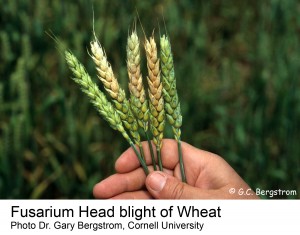 Based upon Oneida County CCE observations, wheat should be at flag leaf stage early next week. As such, now is the time to make decisions on fungicide applications for fusarium head blight. Below are the guidelines for wheat fungicide decisions.
Based upon Oneida County CCE observations, wheat should be at flag leaf stage early next week. As such, now is the time to make decisions on fungicide applications for fusarium head blight. Below are the guidelines for wheat fungicide decisions.
Guidelines for Wheat Fungicide Decisions
(Taken from Cornell Guide for Integrated Field Crop Management)
Does the crop have a reasonable yield potential?
Assess the crop in early May (stem elongation stages) for adequate stand (density of approximately 30 strong stems per foot of row for 7-inch rows on good soils) and plant vigor. If the stand is sparse or plants are not vigorous or show widespread symptoms, fungicide application should not be considered further.
____ Yes ___ No
Have foliar diseases been observed before flag (last) leaf emergence?
Assess upper three leaves for symptoms and signs of powdery mildew, leaf spots, or leaf rust in early to mid-May, before flag leaf emergence. If disease (any amount) is observed on approximately 50 percent of main tillers, averaged across the field, a spray should be considered now. This threshold is exceeded in less than 50 percent of location/year situations in New York, so there is a significant risk of making an unnecessary fungicide application.
____ Yes ___ No
Have foliar diseases been observed during head emergence?
Assess upper two leaves for foliar diseases in late May to early June; if disease (any amount) is observed on approximately 50 percent of main tillers, a spray should be considered now. Fungicide applications made after early June may control some diseases but are unlikely to produce significant yield benefits.
___ Yes ___ No
Are climatic predictions conducive for further disease development?
Powdery mildew development is reduced dramatically once the average daily temperature rises above 70˚F; this disease often disappears by June. Severe leaf spot development is favored by extended periods of wet weather; it may be insignificant if dry weather persists in May and June. Listen for regional advisories on the threat from leaf rust; rust inoculum often builds up in areas to the south and west of New York and is deposited here by thunderstorms in June or July. In addition to disease observations, use long-range local weather forecasts in making your spray decision.
What is your short to medium term weather conditions?
Have I selected fungicides appropriate for the disease spectrum and have I read the label carefully?
Be sure that the materials you spray will be effective against the range of diseases found in your field; e.g., some products effective against powdery mildew are ineffective against leaf spots or vice versa. Check in the Cornell University Guide for Integrated Crop Management: http://ipmguidelines.org/FieldCrops/Chapters/CH05/CH05-7.aspx
Is the spray decision consistent with my perception of risk?
A simple formula for evaluating the relative economics of a fungicide spray is: Relative Profit = (Grain Yield Increase x Grain Price) – (Cost of Fungicide + Application Costs). If ground spray rigs are used, the yield lost to wheel traffic should also be factored in. Each of these variables influences the relative economics of fungicide application as illustrated in Table 5.7.3. of the Cornell University Guide for Integrated Crop Management: http://ipmguidelines.org/FieldCrops/Chapters/CH05/CH05-7.aspx.
Relative Profit = (Grain Yield Increase _____ x Grain Price _____) – (Cost of Fungicide _____ + Application Costs ________)

